The magic of the old…The promise of the new
By Mary Drake –
Looking back:
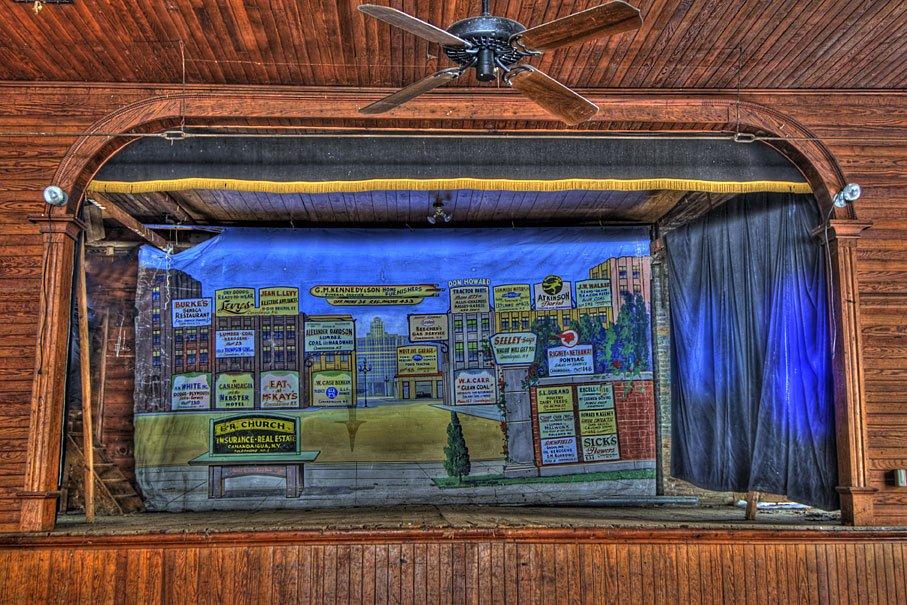
Some people love old buildings, their character, charm and histories. Others wouldn’t have anything but something new, with the latest appliances and modern conveniences. Besides, who wants to fix anything? Well, apparently the Cheshire Community Action Team does. They want to revitalize a 120-year-old building, what is now called The Cheshire Theatre and Meeting Hall, built in downtown Cheshire in 1898.
Now, I write “downtown Cheshire” with tongue in cheek. Cheshire is a hamlet, which by definition is smaller than a village, town, or city. Also, a hamlet is usually considered the satellite of a larger community, which in this case is Canandaigua. Yet residents of Cheshire love their community, with its history and quiet countryside. They also recognize that suburbia is headed their way as farmland sprouts upscale houses instead of crops. Still, they can at least do their part to preserve a piece of Cheshire’s history by refurbishing what began as a meeting hall for The Knights of the Maccabees.
The organization drew its name from the biblical Maccabees, a family of Jewish rebel warriors who accomplished the seemingly impossible task of taking back Judea from the Seleucid empire in the second century B.C.E. Fraternal organizations like The Knights of the Maccabees and The Benevolent and Protective Order of Elks sprang up after the Civil War to help former soldiers. Then, increasing industrialism at the turn of the century and little government assistance for injured workers or widows and orphans led these charitable fraternal organizations to develop programs for their members that were the precursors of commercial life and accident insurance.
Farmers, it seems, wanted insurance as much as factory workers, and this led to a chapter of The Knights of the Maccabees being established in rural Cheshire in 1895. Itflourished, and the KOTM subsequently built their own meeting hall on the main street of Cheshire. It was an imposing one-and-a-half story building with a center gable that made it stand out. (As a point of interest, the KOTM constructed the building before they had even finished negotiating the purchase of the property it was built on! A strange way to operate, by modern standards.)
Besides providing life insurance to their members, fraternal organizations were also social groups. The new hall had a raised stage with a curtain, a kitchen, and a meeting hall that also doubled as a dance floor. The Ontario County Times of the day reports the success of a dance that celebrated the opening of the building. One can imagine the fiddlers on stage playing old-time country music as horse-drawn wagons poured in from the surrounding countryside braving the rainy weather so that farmers and their wives could enjoy this rare opportunity for entertainment.
In its early days, Cheshire’s main street was a well-travelled wagon trail, and the hamlet was centrally located at the meeting point of several main roads. It was a thriving agricultural, social and commercial center, which hoped to someday “out-strip” Canandaigua. The Maccabees thought that the meeting hall would make Cheshire even more of a destination. People would come there for dances, suppers, concerts, or plays, such as those put on by the Cheshire Dramatic Club.
Soon the roaring twenties brought Vaudeville to the KOTM’s meeting hall: think trained animals, singers, dancers, acrobats, magicians, and comedians of all types. Vaudeville has been described as “a farce with music,” and the meetinghouse stage was just the place for this popular form of entertainment to be performed. The Cheshire Amusement Company was established to meet the entertainment needs of this growing community. 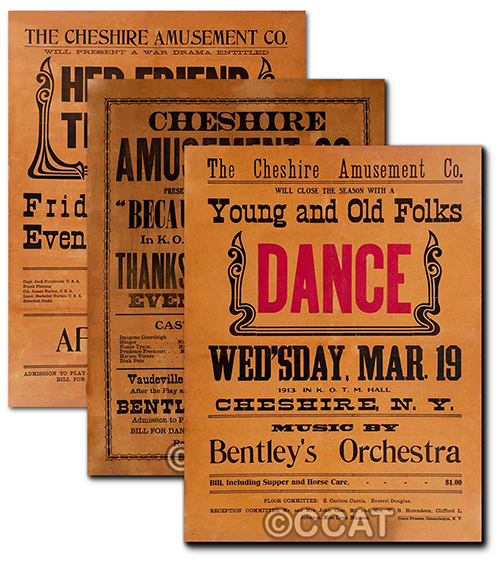
Besides Vaudeville, there were the productions of popular plays, like Young Mrs. Winthrop, a four-act drama, and the presentation of a long poem called An Old Sweetheart of Mine by popular Indiana poet of the time, James Whitcomb Reilly. But as much as people loved plays, it seems like they liked nothing better than a good shoe-stomping, heart-pumping dance. These were offered after the play and were likely a big draw.
A meal was usually served as well, either lunch or dinner. Original turn-of-the-century playbills note that horse care was also available, since “horseless carriages” must not yet have been prevalent. After all, the Model T didn’t become economical enough for the average American until 1920, and it would have taken even longer before it was a common sight in rural America.
An advertisement for a Masquerade Ball held on January 31, 1913, at the KOTM hall also lists a “Grand March” at 9 PM. One can imagine the women in their long-waisted, beaded velvet evening gown, wearing cloche hats, on the arms of men in short tuxedoes with satin lapels, wearing fedoras, promenading down Cheshire’s Main Street before entering the meeting hall, donning their masks and beginning to dance. What a grand sight it must have been! And for only a quarter, one could stand and watch.
These were the busy days of the meeting hall that provided hard-working local farmers and laborers with a source of culture, entertainment, and socialization. In 1920, The Knights of the Maccabees sold their meeting hall to another fraternal organization, The Grange, the oldest fraternal organization in America to promote agriculture. Even then, The Grange, as it was then called, continued to be a hub of social activity for many years.
Now…and to come:
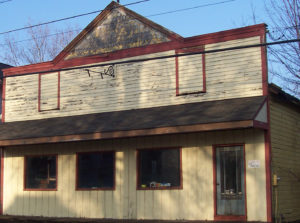
Nothing lasts forever, and, in 1970, The Grange became privately owned and was transformed into an antiques store, which it remained for 30 years. Gradually, it fell into disrepair and the building was abandoned for 10 years, during which time it suffered serious water damage as the roof began to cave in. This once vital meeting place in the center of Cheshire had become an eyesore.
Enter the Cheshire Community Action Team.
Organized in 2005, CCAT is the brainchild of Fred and Nancy Goodnow. Fred is a third generation native of Cheshire and Nancy
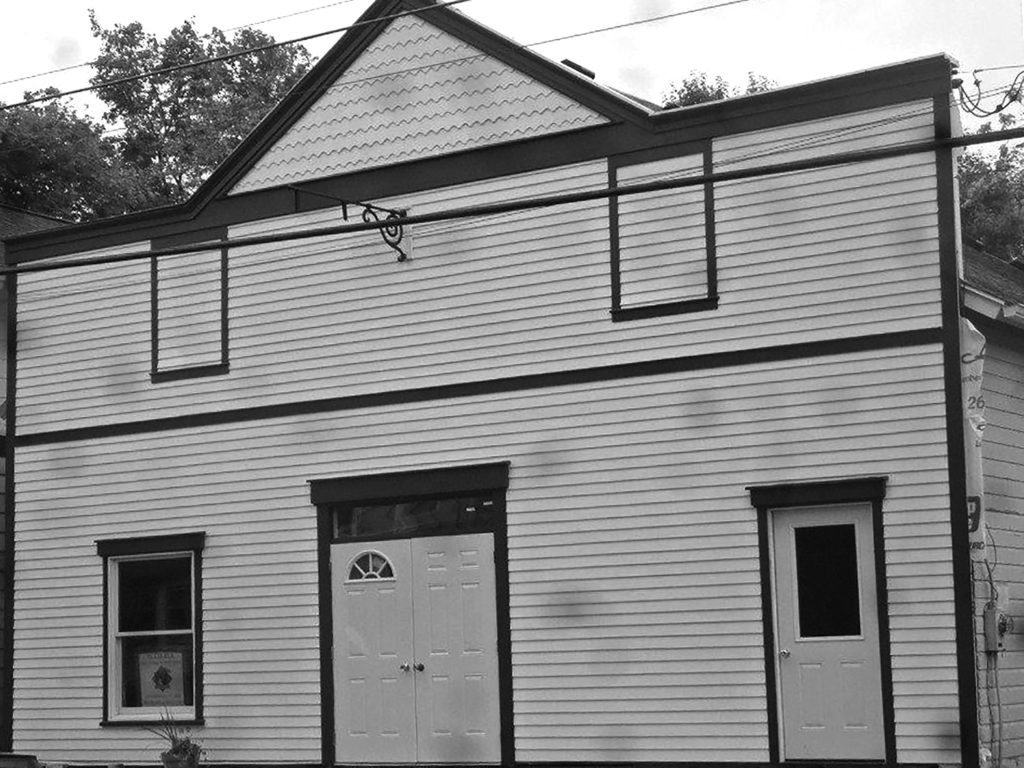
is a lover of American history who wants to preserve what our ancestors have created and valued. Together, this energetic pair has rallied the residents of their small hamlet to contribute time, labor, and effort towards saving the historic building. It is a story that is repeating itself in many smaller communities, as residents seek to rebuild and revitalize historic structures that once served as social centers. Such projects are massive undertakings that require the support of many people, and the Grange was no exception
“Before anything could be done to the structure, we had to do a massive clean out,” Fred told me. The building was filled from ceiling to cellar with “antiques” from the former storeowner. “We filled three furniture vans and two flatbed trucks, and had an overflowing dumpster,” he said. They also had to clean out a large number of bats who had taken up residence during the years the building stood empty. “Then the first order of business was to stabilize the sagging hundred-year-old structure.” Fred showed me a steel beam in the basement that now runs the length of the building. A partial concrete floor in the basement had to be removed using sledgehammers in order to level the dirt floor prior to pouring a new one. The Goodnows have been involved every step of the way, along with many volunteers. When I asked how an older person like Fred, who is in his seventies, could have done such heavy work, he said that he’s always tried to stay fit. Apparently he’s done a good job.
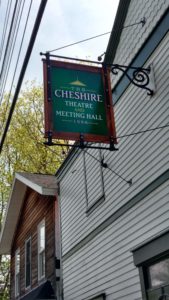
The CCAT intends to “restore to the extent possible and refurbish this historic structure similar to the original purpose as it was when used by The Cheshire Amusement Company of 1898,” says their website. Of course they will bring the building up to code and make it handicap accessible, but otherwise they hope to keep it as close to the original 1898 building as possible. Towards that end, the team will re-establish in the entryway the building’s first ticket counter, now an antique; repoint the original stone foundation; restore the curtains and backdrops used for turn-of-the-century plays and shows; and even keep in place the hat boxes men and women used in the early 1900s. Fred told me that each board that was taken down in the basement has been numbered so that it can be replaced exactly as it was, in order to preserve graffiti from the 1920s or earlier.
A sound system will be installed as well as new stage lights to ready the building for theatrical and musical productions. But the CCAT isn’t stopping there. The downstairs will house a commercial kitchen for dinners and parties, with appliances donated by Wegmans, as well as a conference room. Planners envision art exhibitions, children’s birthday parties, craft groups, and even a lending library.
The Knights of the Maccabees would truly be proud of their refurbished building which will preserve the best of the old while offering modern amenities. The Goodnows as well as the entire CCAT, who have donated so much of their time and effort towards the building’s restoration, and continue to do so, hope to help revitalize their community and make The Cheshire Theatre and Meeting Hall a destination once again.